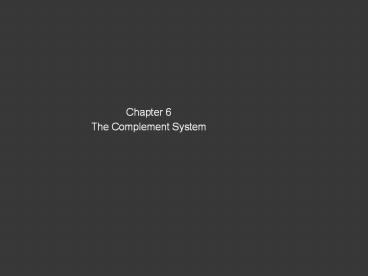The%20Complement%20System - PowerPoint PPT Presentation
Title:
The%20Complement%20System
Description:
Title: Kuby Immunology 6/e Author: Kindt, Goldsby, Osborne Last modified by: sb Created Date: 12/24/2002 1:08:46 AM Document presentation format: On-screen Show (4:3) – PowerPoint PPT presentation
Number of Views:203
Avg rating:3.0/5.0
Title: The%20Complement%20System
1
- Chapter 6
- The Complement System
2
Complement System
- Major effector branch of humoral immune system in
vertebrates - However, invertebrates possess proteins related
to complement system - Even sea urchins have complement
3
Functions of Complement
4
- 7 Functional Categories
- Initiate complement components
- Enzymatic mediators
- Membrane binding (opsonins)
- Inflammatory mediators
- Membrane attack proteins
- Complement receptor proteins
- Regulatory proteins
5
Components of Complement
- Soluble proteins and glycoproteins
- Synthesized mainly by liver hepatocytes and other
cell types - 5 of serum globulins
- Circulate as inactive proenzymes proteolytic
cleavage removes inhibitory fragment and exposes
active site
6
Components of Complement
- Designated by numerals, letter symbols, or
trivial names - Examples C1-C9, factor D, homologous restriction
factor - Peptide fragments made by activation
- a for smaller fragment C3a
- b for larger fragment C3b
- Complexes with enzymatic activity have bar on top
C4b2a
7
Complement Activation
- Early steps resulting in C5
- Can occur by 3 pathways
- Classical
- Alternative
- Lectin
- Final steps leading to membrane-attack complex
(MAC) are identical in all 3 pathways
8
(No Transcript)
9
Classical Pathway
- Antibody Dependent
- Activated by Ag-Ab complex (most commonly IgM and
IgG) - Early stages involve C1, C2, C3, and C4
10
Classical Pathway
- What C1 looks like
11
Classical Pathway
12
Classical Pathway
13
Classical Pathway
14
Classical Pathway
15
Classical Pathway
16
Alternative Pathway
- Antibody-Independent
- Component of innate immune system
- Early stages involve C3, factor B, factor D, and
properdin - Initiated by cell surface constituents foreign to
host - For example Gram- and Gram bacteria
17
(No Transcript)
18
Alternative Pathway
19
Lectin Pathway
- Antibody-Independent
- However, proceeds more like classical pathway
- Uses C4 and C2
- Activated by binding of mannose-binding lectin
(MBL) to mannose residues on glycoproteins or
carbs on surface of microorganisms
20
Membrane Attack Complex (MAC)
- Forms pores in cell membrane
- Ions and small molecules can freely pass through
pores - Cell cannot maintain osmotic stability
21
(No Transcript)
22
Regulation
- Components are capable of attacking host cells
- Components undergo spontaneous inactivation if
they are not stabilized with other components - C3 convertase is major amplification step in all
3 pathways - Regulatory proteins are present that control C3
convertase
23
(No Transcript)
24
(No Transcript)
25
Biological Consequences of Complement Activation
- Amplifies humoral response and causes it to be an
effector response - Lyse cells
- Participate in inflammatory response
- Opsonization of antigen
- Clearance of immune complexes
26
Cell Lysis
- MAC and lyse broad spectrum of cells
- Gram bacteria generally more resistant because
of thick peptidoglycan - Some have developed ways to evade MAC
27
(No Transcript)
28
Mediating Inflammation
- Cleavage products of complement components
mediate inflammation - Smaller fragments bind to basophils and mast
cells - C3a and C5a (anaphylatoxins) induce smooth muscle
contraction and increase vascular permeability
29
Opsonization
- C3b and C4b have opsonizing activity cause
phagocytosis
30
Viral Neutralization
- Binding of antibody and complement to viruses
blocks attachment to susceptible host cells
31
Clearing of Immune Complexes
- Tissue damage can result from build up of immune
complexes - C3b coats immune complexes
- RBC have capability of binding C3b coated
complexes and carrying them to liver and spleen
to be cleared - Deficiencies with any of complement may result in
improper binding of C3b and loss of clearing may
occur
32
(No Transcript)
33
(No Transcript)
34
Introduction to Complement https//www.youtube.co
m/watch?v_5bj0oUrqDQ

